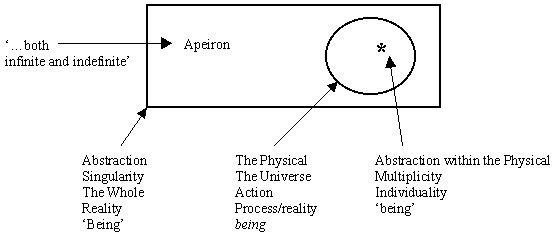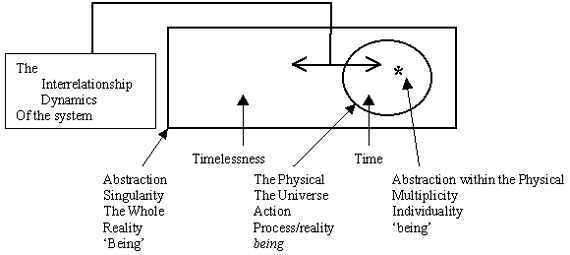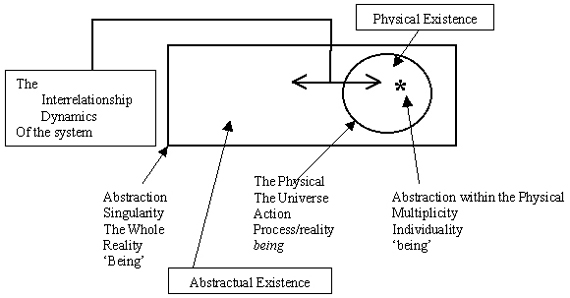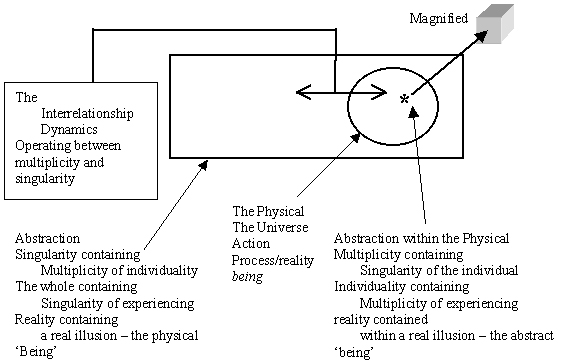|
 
 
Conclusion : The Peer Review : Western Philosophy (continued)
3. The Pre-Socratics – Q2:
What is knowledge?
From the very beginning, the Ionians were willing to embrace new ideas and perceptions. In so doing, they were able to shape those ideas and perceptions to new purposes. For example, both Babylonian astronomy and Egyptian geometry were vital as an aid to maritime navigation. Using these tools, in such a revolutionary new manner, allowed them to trade with diverse cultures scattered all around the Eastern Mediterranean. In so doing, they were exposed to new knowledge and perceptions.
S: Through the new metaphysical model, we obtain a new understanding regarding what knowledge is. Knowledge is ‘what is’ and in fact knowledge is ‘created’ thus producing ‘what could be’ but ‘isn’t’. Knowledge is the means by which ‘what is’ ‘grows’. For such a creative process to exist, knowledge must not just ‘be’ but knowledge must ‘be known’. In other words, the verb of action must be applied to the noun of existence. Such a process of ‘creating knowledge’ circumvents Nietzsche’s concept of eternal recurrence.
The new metaphysical model of ‘being’ being ‘Being’ suggests the engine of such a dynamic model lies with the concept of multiplicity/individuality. If such is the case, then the means of changing the historical vector generated by human behavior lies within an understanding regarding the significance of the individual and the role the individual has to play regarding the very expansion of the whole of knowledge.
The Pre-Socratics may not have consciously understood the process of ‘creating’ knowledge’ but the Pre-Socratics did intuitively understand the significance of knowledge and as such the Pre-Socratics expanded the respect due a greater number of individuals, which in turn increased the potential development of the practical use of knowledge, which in turn exponentially expanded the potential development of new knowledge (the noun) itself.
We create knowledge, which in turn circumvents the state of permanent equilibrium for the whole, which in turn circumvents the state of eternal recurrence for the whole. If new knowledge were never created, the whole/singularity/God would have no choice but to eternally watch and experience the sum total of knowledge reruns, since the whole/singularity/God is eternal in nature.
We create knowledge in many ways. We ‘create’ new knowledge through art, music, literature, and perhaps as Hegel suggests through observation/science itself. We create knowledge in the form of experiencing be it the forms of experiencing natural events occurring within the physical, which surrounds us, or in the form of actions we intentionally precipitate through choice, free will.
Knowledge is created but knowledge created with ‘no knowing’ capable of perceiving knowledge, be it perceiving by the whole/singularity/God or be it perceiving by various forms of multiplicity/individuality, is no knowledge at all for knowledge the noun exists only through knowing the verb, through action.
Passivity of knowing is knowledge but simultaneously passivity of knowledge is no different than ‘life’ without action. Just as life is an action noun, knowledge is an action noun. Knowing of knowledge is the action, which gives knowledge its life.
The point: Multiplicity/individuality/the individual is the key element in the process of singularity’s/the whole’s/God’s ability to circumvent the boredom of eternal reruns. Understanding such a concept, possessing such knowledge leads to the recognition regarding morality: the first of society’s obligation is to protect the right of the individual to travel life unimpeded and the second obligation is to travel life unimpeded is a critical issue to the system.
4. The Invention of Philosophy – Q1:
What is reality?
Thales of Miletus (585 B.C.)
The invention of philosophy is attributed to Thales of Miletus … Thales was considered to be one of the Seven Wise Men or Sophoi…. They desired to strip away all dogma in order to get to the underlying truth of nature. The study of the origin and nature of the physical world was their highest priority: all else was discarded.
S: Of the twelve questions presented in ‘ Section 1. Introduction’, perhaps the least complex to question to answer is the question: What is reality? This is not to say such a question does not tax our scientific, religious, and philosophical abilities to the limit. In the time of Thales of Miletus the question was thought to encompass the ‘underlying truth of nature’. But through time the concept of ‘nature’ has evolved to mean the physical and eventually to mean the universe.

The diagram illustrates why our philosophical thinking has gravitated towards the perception that the abstract is an innate characteristic of the physical.
It was not the speculation of Thales of Mellitus, which led us to such a perception. What led us to such a perception was our predominant reliance upon observation spurred by science, which did so.
We can use graphics to demonstrate what reality is in terms of the new metaphysical perception presented in this work.
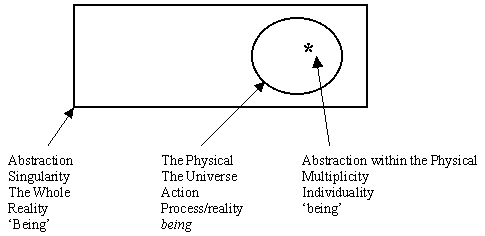
The point: The new metaphysical perception leads us to the understanding that the abstract of individuality, the abstract in the form of multiplicity, is not an innate characteristic of the physical but rather that the physical is an innate characteristic of the abstract as opposed to our present perception that the abstract is an innate characteristic of the physical.
4. The Invention of Philosophy – Q2:
What is reality?
Anaximander (612-545 B.C.)
Thales’s student, Anaximander … recognized that the world, and cosmos, was in a constant state of change. He proposed to explain this change by referring to the Apeiron. The Apeiron was something both infinite and indefinite. Within it, the four states – hot, cold, wet, and dry – arose. Anaximander believed that the conflict and interaction of these states gave rise to the cosmos, the earth, and to life.
S: Anaximander’s ‘Apeiron’, simply becomes the name for abstraction within the new metaphysical model being examined within this work.
The concept of the world now expands to become the universe and the cosmos, which now expands into being the region outside the universe within which the universe finds itself located. In other words the universe/the physical is located within abstraction or the Apeiron.
The ‘constant state of change’ becomes the means by which Nietzsche’s dilemma regarding ‘eternal recurrence’ and by which present day science’s dilemma regarding the concept of permanent equilibrium become resolvable.
‘Newness/change’ is ‘created/initiated’ within the mechanism of the universe and becomes a part of the Apeiron but does not ‘change’ the Apeiron in the sense we perceive change to take place. The full discussion of such a concept is addressed in Tractate 6: The Error of Kant. It is the tractate regarding Kant that the dialectic regarding a region changing but remaining unchanged is found.
If one then proceeds to ‘… strip away all the dogma of order’ from within the new metaphysical model of reality, as Thales of Miletus suggests, one can then find ‘…Within it, the four states – hot, cold, wet, and dry existing as forms of abstractual existence. Anaximander believed that the conflict and interaction of these states gave rise to the cosmos, the earth, and to life’.
Abstractually the states of hot, cold, wet, and dry take on a symbolic analogous state represented by the concepts of ‘being’/multiplicity/individuality – noun, being/existence – passive verb, being/process – verb of action, and ‘Being’/singularity/the whole – noun within the new metaphysical system.
The point: Through the development of symbiotic panentheism, ‘being’ being ‘Being’, reality now becomes an expanded perception of what we previously perceived it to be. Reality now becomes the sum total of physical reality as well as the whole of abstractual reality within which physical reality finds itself.
4. The Invention of Philosophy – Q3:
What is reality?
Anaximenes (545 B.C.)
… Anaximenes believed that there must be a single form of "stuff" as the primary source of everything. He suggested that vapor or mist was this "stuff."
S: We know now that vapor is simply a gaseous form of water. Does having learned the nature of vapor mean Anaximenes was incorrect in his perceptions regarding the source of ‘everything’? Absolutely not, Anaximenes used the concept of vapor merely to exemplify the potential source of ‘everything’. Just because we have shown vapor is not the source of everything does not mean we have invalidated Anaximenes’ intuitive grasp of everything having a source from which it forms.
Tractate 10: The Error of Heidegger provides an in-depth examination regarding the source of every-thing’ Within Tractate 10, the ‘vapor’ or ‘mist’ to which Anaximenes refers is examined in light of metaphysical thought as it relates to modern science. The underlying principle of physics, namely symmetry, is factored into the dialectic along with the very functionality of’ nothingness’.
To discuss the details regarding the ‘source’ of every-‘thing’ within the context of this conclusion is impractical. What can be practically stated at this point, however, is that many philosophers believe that any newly developing metaphysical system demonstrates its validity through the process of reinforcing past philosophical concepts as opposed to casting out all the ‘old’ to make room for the new. The new metaphysical model presented in the work, The War and Peace of a New Metaphysical Perception, embraces the ‘old’, embraces past philosophical ideas and rejects the concept that it, the new system, should replace the ‘old’ concepts of philosophy.
Simply put abstraction is substituted for the Anaximenes’ ‘vapor’ in the new metaphysical perception of ‘being’ being ‘Being’ being.
The point: Anaximenes’ concept is not being rejected as incorrect or inadequate by the new model of reality being introduced by this work. What the new metaphysical system does do is validate Anaximenes’ intuitive thoughts through the process of updating them with science’s more advanced observations regarding our physical universe.
4. The Invention of Philosophy – Q4:
What is reality?
Heraclitus (500 B.C.)
… He saw the natural world as an environment of struggle and difficulty and concluded, "all was flux" and was ever changing.
S: If reality is as Heraclitus perceived it, the question emerges: How is it that the new metaphysical model embraces a Heraclitus’ concept of ‘all’ being in flux if change takes place in the universe and constancy is a universal aspect of the fabric which lies ‘outside’ the universe? Wouldn’t an unchanging exterior to the universe imply change in fact was not occurring?
The answer to the question lies in the understanding that an unchanging ‘outside’ in fact changes while remaining unchanged. It would appear the concept of the ‘outside’ of the universe being in constant flux while never changing is a nonsensical concept. The issue was discussed in great detail within Tractate 6: The Error of Kant. Again the issue is too complex to address in the short space provided here.
The concept of change is a concept, which requires the entity changing to be immersed within time as opposed to having time immersed within the entity. Since the region ‘outside’ the universe is void time as a universal fabric the region ‘outside’ time cannot change even if it appears to do so. Again the understanding of such a concept is discussed in great detail within Tractate 6: The Error of Kant.
Again we can use diagrams to illustrate the new perception of reality. The diagram not only illustrates the passive state of existence, timeless existence, and the universal fabric of time but also illustrates both forms of action, the passive state and the active state, as they are found to exist in reality.
Again we find the new metaphysical system embraces the ‘old’ rather than replaces the ‘old’. As illustrated, the concepts
initiated by the ‘Wise Men of Sophoi’ are fully embraced within the new system being introduced within this work..
The point: Heraclitus’ concepts are not replaced by the new metaphysical model of reality but rather Heraclitus’ concept of ‘all’ being in flux, the idea that the verb of action as well as the passive state of existence, is a part of reality, is a concept which becomes a critical element of the new metaphysical system.
5. The Eleatics – Q1:
What is reality?
The Eleatics rejected the views of Heraclitus, and defended the stability and unity of the natural world. Parmenides, founder of the school of Eleaticism, stated that "what exists" cannot come into being, nor can it pass away, because it would have to either come out of nothing, or to become nothing – whereas nothing, by its very nature – does not exist. It follows that there can be no motion, for how can one object occupy the space of another? Our perception of change is thus an illusion. This idea – for its time – was revolutionary. For the first time, it introduced the idea that there are two forms of truth: the real and the perceived.
S: The paradox regarding the very existence of ‘nothingness’ and the functionality of such an existence is extremely important metaphysically and therefore the concept regarding the existence of nothingness and the functionality of nothingness is given its own tractate within this work: Tractate 10: The Error of Heidegger.
In terms of the new metaphysical model espoused by this work, the Eleatics are correct but simultaneously the Eleatics are not correct. The Eleatics’ observations and their intuitive perceptions that nothingness does not exist are accepted as observationally correct and intuitively correct when examined from within the reality of the physical. (See Tractate 10)
Within the reality of abstractual existence, however, nothingness is demonstrated to both exist and to exist with a purpose, to exist with a function, just as do all forms of existence found within the whole, found within singularity, found within ‘Being’. (See Tractate 10)
As we have found so often to be the case, the new metaphysical model does nothing to expunge our repositories of human knowledge but rather embraces the ideas of previous thinkers. The new model of reality acts as the mortar, which holds together the intuitive perceptual building blocks developed by humanity.
The point: Nothingness may not exist within the ‘reach’ of our present day abilities defining scientific study. Nevertheless, nothingness does exist within the ‘reach’ of our present day abstractual abilities to reason, within abstraction, within Apeiron’s existence. With the existence of two ‘realities’ comes the realization that their can be ‘… two forms of truth: the real and the perceived.’ and that each form of truth is in fact ‘truth’.
5. The Eleatics – Q2:
What is reality?
Zeno of Elea,
… he attempted to demonstrate the absurdity of the idea that the world is constantly changing. …Zeno used these paradoxes to demonstrate that by accepting the idea of motion - and change of any kind – we arrive at absurd conclusions. We should therefore reject "change" as a natural part of the world. How can there be unity in a world that appears to be multiple?
S: The new metaphysical model demonstrates how and where it is possible to have change occur without change taking place. Such a location occurs where there is a lack of a universal fabric of time and thus in essence a lack of change. (See Tractate 6)
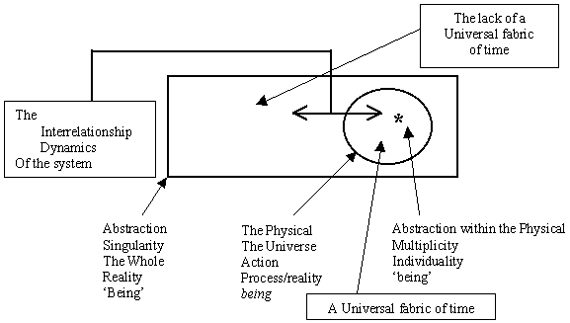
The new metaphysical model also demonstrates both how and where it is possible to have change emerge out of the very seed of this ‘thing’ called nothingness. (See Tractate 6)
In essence both the Eleatics and Heraclitus were correct for each had a piece of the puzzle regarding the nature of reality.
The point: The great thinkers of the past, who represent humanities journey to understand reality and our function within reality, have been in conflict not because their intuitive instincts were incorrect. The deep thinkers of the past were in conflict with each other because they rejected each other. The thinkers of the past perceived reality to be ‘either’ physical in nature or ‘abstractual’ in nature when in truth there is a third possibility: The new metaphysical model demonstrates reality can be literally both abstractual and physical in nature simultaneously. When one stands in physical existence the physical is real while the abstract is a real illusion. When one stands in abstractual existence the abstract is real and the physical is a real illusion. (See Tractate 1)
There are many existing pieces to the puzzle regarding the complete picture of reality and we cannot, must not, throw away any of them if we are ever to complete the entire mosaic of reality.
6. Empedocles, Plurality, and Greek Atomism – Q1:
What is existence?
The Atomists – Leucippus (440 B.C.), Epicurus (341-271 B.C.), and Democritus (460-370 B.C.) – attempted to counter the position put forward by Parmenides by introducing plurality back into our worldview.
S: Singularity or multiplicity, ‘…there is but one solid being’ (Zeno section 5 of Tractate 18) or there is plurality of existence (Heraclitus section 4 of Tractate 18, all knowing or individual elements of knowing, singularity of knowledge or elements of knowledge, the knowing of all or the knowing of parts, monism or dualism: These are all fundamentally the same conflicting issues.
The past debates hinged upon which of the two choices was the correct choice.
The new metaphysical perception clearly states we have been debating the issue as an ‘either’/‘or’ issue due to the fact that we perceived we only had two choices available from which to chose.
We perceived either:
Cartesainism exists: multiplicity, individuality, ‘being’s’ (plural), elements of knowledge (plural), elements (plural) of knowing, souls (plural), change, nothingness and something, … exist
or
Non-Cartesianism, singularity, the whole, ‘Being’ (singular), the sum of Knowledge, the sum of Knowing, God, constancy, no nothingness, …exists.
The new metaphysical model suggests we have a third perception from which to choose. It is possible existence is both singularity and multiplicity simultaneously.
The point: The third option for a metaphysical system is developed through the fusion of the two as opposed to being forced to accepting only one or the other metaphysical perceptions.
|
|
|






